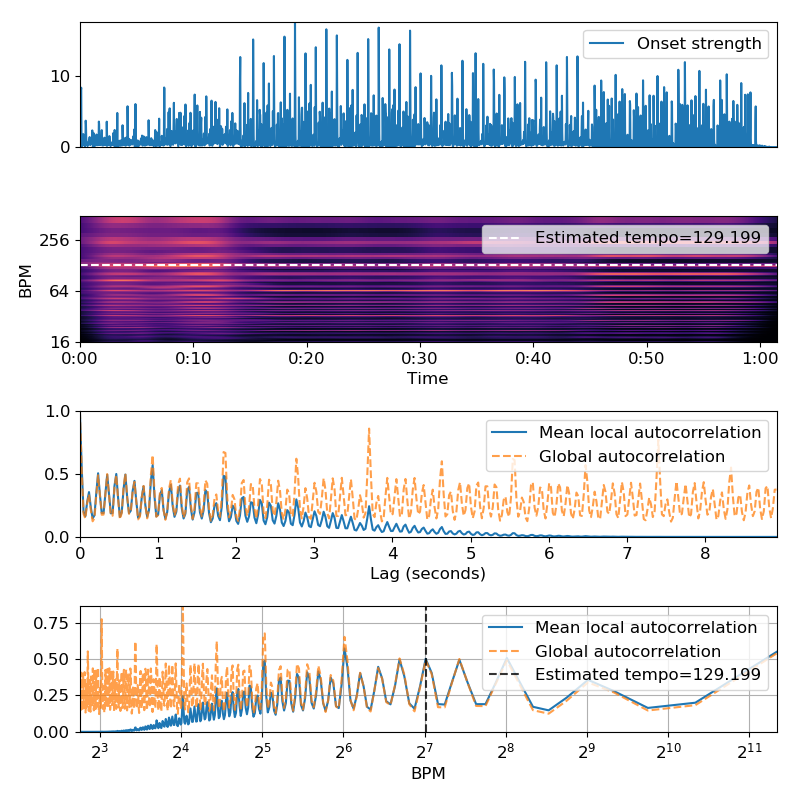librosa.feature.tempogram¶
-
librosa.feature.tempogram(y=None, sr=22050, onset_envelope=None, hop_length=512, win_length=384, center=True, window=’hann’, norm=inf)[source]¶ Compute the tempogram: local autocorrelation of the onset strength envelope. [1]
[1] Grosche, Peter, Meinard Müller, and Frank Kurth. “Cyclic tempogram - A mid-level tempo representation for music signals.” ICASSP, 2010. Parameters: - y : np.ndarray [shape=(n,)] or None
Audio time series.
- sr : number > 0 [scalar]
sampling rate of y
- onset_envelope : np.ndarray [shape=(n,) or (m, n)] or None
Optional pre-computed onset strength envelope as provided by onset.onset_strength.
If multi-dimensional, tempograms are computed independently for each band (first dimension).
- hop_length : int > 0
number of audio samples between successive onset measurements
- win_length : int > 0
length of the onset autocorrelation window (in frames/onset measurements) The default settings (384) corresponds to 384 * hop_length / sr ~= 8.9s.
- center : bool
If True, onset autocorrelation windows are centered. If False, windows are left-aligned.
- window : string, function, number, tuple, or np.ndarray [shape=(win_length,)]
A window specification as in core.stft.
- norm : {np.inf, -np.inf, 0, float > 0, None}
Normalization mode. Set to None to disable normalization.
Returns: - tempogram : np.ndarray [shape=(win_length, n) or (m, win_length, n)]
Localized autocorrelation of the onset strength envelope.
If given multi-band input (onset_envelope.shape==(m,n)) then tempogram[i] is the tempogram of onset_envelope[i].
Raises: - ParameterError
if neither y nor onset_envelope are provided
if win_length < 1
Examples
>>> # Compute local onset autocorrelation >>> y, sr = librosa.load(librosa.util.example_audio_file()) >>> hop_length = 512 >>> oenv = librosa.onset.onset_strength(y=y, sr=sr, hop_length=hop_length) >>> tempogram = librosa.feature.tempogram(onset_envelope=oenv, sr=sr, ... hop_length=hop_length) >>> # Compute global onset autocorrelation >>> ac_global = librosa.autocorrelate(oenv, max_size=tempogram.shape[0]) >>> ac_global = librosa.util.normalize(ac_global) >>> # Estimate the global tempo for display purposes >>> tempo = librosa.beat.tempo(onset_envelope=oenv, sr=sr, ... hop_length=hop_length)[0]
>>> import matplotlib.pyplot as plt >>> plt.figure(figsize=(8, 8)) >>> plt.subplot(4, 1, 1) >>> plt.plot(oenv, label='Onset strength') >>> plt.xticks([]) >>> plt.legend(frameon=True) >>> plt.axis('tight') >>> plt.subplot(4, 1, 2) >>> # We'll truncate the display to a narrower range of tempi >>> librosa.display.specshow(tempogram, sr=sr, hop_length=hop_length, >>> x_axis='time', y_axis='tempo') >>> plt.axhline(tempo, color='w', linestyle='--', alpha=1, ... label='Estimated tempo={:g}'.format(tempo)) >>> plt.legend(frameon=True, framealpha=0.75) >>> plt.subplot(4, 1, 3) >>> x = np.linspace(0, tempogram.shape[0] * float(hop_length) / sr, ... num=tempogram.shape[0]) >>> plt.plot(x, np.mean(tempogram, axis=1), label='Mean local autocorrelation') >>> plt.plot(x, ac_global, '--', alpha=0.75, label='Global autocorrelation') >>> plt.xlabel('Lag (seconds)') >>> plt.axis('tight') >>> plt.legend(frameon=True) >>> plt.subplot(4,1,4) >>> # We can also plot on a BPM axis >>> freqs = librosa.tempo_frequencies(tempogram.shape[0], hop_length=hop_length, sr=sr) >>> plt.semilogx(freqs[1:], np.mean(tempogram[1:], axis=1), ... label='Mean local autocorrelation', basex=2) >>> plt.semilogx(freqs[1:], ac_global[1:], '--', alpha=0.75, ... label='Global autocorrelation', basex=2) >>> plt.axvline(tempo, color='black', linestyle='--', alpha=.8, ... label='Estimated tempo={:g}'.format(tempo)) >>> plt.legend(frameon=True) >>> plt.xlabel('BPM') >>> plt.axis('tight') >>> plt.grid() >>> plt.tight_layout()
